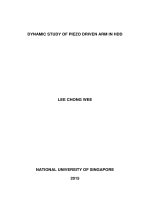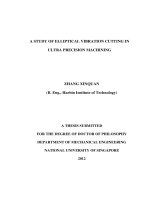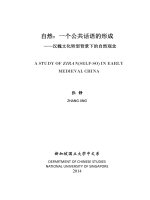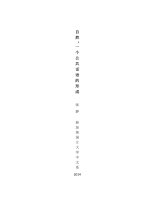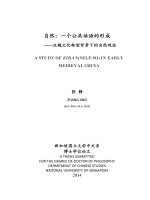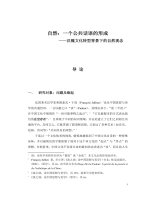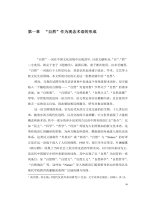Dynamic study of piezo driven arm in HDD
Bạn đang xem bản rút gọn của tài liệu. Xem và tải ngay bản đầy đủ của tài liệu tại đây (6.31 MB, 204 trang )
DYNAMIC STUDY OF PIEZO DRIVEN ARM IN HDD
LEE CHONG WEE
NATIONAL UNIVERSITY OF SINGAPORE
2015
DYNAMIC STUDY OF PIEZO DRIVEN ARM IN HDD
LEE CHONG WEE
A THESIS SUBMITTED
FOR THE DEGREE OF DOCTOR OF PHILOSOPHY
DEPARTMENT OF MECHANICAL ENGINEERING
NATIONAL UNIVERSITY OF SINGAPORE
2015
ABSTRACT
Thanks to the rapid improvements in the development of better piezoelectric materials, more
precise fabrication capabilities as well as power electronics circuitry, Ultrasonic Motors
(USMs) are beginning to find more applications in many engineering applications. One such
potential application is in the area of Hard Disk Drives (HDD) as a precision actuation device
for actuator arm placement and seeking of data tracks on disk. However, the actual
implementation of such an actuation technology faces serious impediments as preliminary
studies reveals several major issues that concerns its vibration robustness, speed-torque
sufficiency as well as acoustical noise issues.
Preliminary experimental data on a prototype HDD piezo actuator arm has indicated several
issues with their dynamical performances. First, experimental transfer function measurement
of the prototype shows a significant response occurring at around hundreds of hertz. This low
frequency rippling will result in severe interference when doing track positioning. Second,
the ultrasonic excitation frequency (120 kHz) content was found to have been transmitted to
the HDD slider. This should not surprise as the slider resonant frequencies are also in the
range of hundreds of kilohertz. Again, this means degradation in read/write performance as
there is an additional unwanted vibration component. Third, the torque and hence seeking
speed of the piezo arm is slower and less powerful than a traditional Voice Coil Motor (VCM)
actuator arm. This will further translates to a slower data transfer rate and also degrade the
control speed and bandwidth.
Most studies available in the literature do not concern themselves with the detailed study of
the dynamical motion of the rotor. The lack of literature concerning the above issues stems
from the fact that rotor vibrations are not the main concern in the design of USM. Insofar as
rotor vibrations are studied, it is because they can affect the overall motor performance in
terms of the speed-torque characteristics that the study is undertaken. Rotor vibrations are not
studied explicitly for its own sake as overall motor performance still takes precedence. The
second reason is that rotor vibrations are inconsequential for most applications and therefore
do not enter into the radar of researchers. For precision positioning stages, the operation of
the USM is often perform statically or quasi-statically, this means that rotor vibrations, if
present, are allowed to damp out naturally. On the other hand, if the USM is functioning as a
motor, the vibrations of the rotor would be insignificant compared to the dynamically moving
rotor. However, the situation is very different when we are considering the application of
USM to drive the actuator of a HDD. Now, not only is motor performance important, the
vibrations of the rotor also take center stage. This is because the vibration of the rotor is
synonymous with the vibrations of the actuator arm. To ensure superior read/write
performance, it is necessary to keep the vibrations of the actuator arm and hence the USM
rotor to the bare minimum.
The objective of this thesis is to develop an analytical model of a Travelling Wave Rotary
Ultrasonic Motor (TRUM) capable of capturing the rigid body dynamics of rotor motion as it
interacts with the stator vibrations. The goal of the study is to allow designers to study the
vibrations experienced by the rotor during TRUM operation. Due to the highly non-linear
nature of operation of a TRUM, a purely finite element based approach to capture its
dynamical behavior would be highly impractical as the very fine mesh and time step
requirements would make the computational effort humungous. The analytical based
modeling approach is coupled with numerical finite element method in the study. FEA is
employed in the initial extraction of natural frequencies and mode shapes vibration data for
complex geometries while the analytical model takes care of the dynamical computation. An
energy approach using a modified Hamilton’s Principle for electromechanical system is
employed in the formulation. Rayleigh-Ritz assumed modes are used in the description of the
vibration modes. Non-linear interfacial forcing terms which arises during physical contact
between rotor and stator surfaces has also been accounted for and included into the model. A
contact search algorithm was also implemented in order to track and update system
parameters in line with the time evolving states of contact between the rotor and stator
surfaces. Given the system inputs, general motor performance measures such as its speed-
torque characteristics, power consumption, efficiency as well as rotor vibration profile can be
obtained through the model. To obtain experimental results, a prototype TRUM based
actuator arm was fabricated. Simulation and experimental results were corroborated to verify
the effectiveness of the analytical model.
An analytical simulation platform using results computed with numerical finite element
method for the study of the dynamical behavior of a TRUM was developed. The approach
presented here has provided us with valuable insights into the mechanics and dynamical
behavior of TRUM. The analytical foundation which included the description of rotor
dynamics of TRUM established here enables the possibility of better design for improved
vibration isolation and speed performance when TRUM is used as a HDD actuator. It also
represents a general framework whereby further modeling of other kinds of USM design is
possible as well as serves as a useful design tool which can be used to optimize motor
parameters before the actual fabrication or prototyping. With such a tool, it will contribute to
improved quality of TRUM while at the same time reduce product development cycle time
and cost.
ACKNOWLEDGEMENTS
I would like to express my deepest gratitude to both my supervisors, Associate Professor
S.P Lim from the Mechanical Engineering Department, National University of Singapore and
Dr Lin Wuzhong, my colleague at Data Storage Institute, A-Star Singapore, who is now with
the Singapore University of Technology and Design. I am deeply appreciative for their
friendship and guidance during my study. Their encouragement and patience with me is most
outstanding and I am very grateful to be under their care for these few years.
I would like to thank my colleagues over at Data Storage Institute who have helped me a lot
during the course of my study. They are excellent friends and colleagues and I greatly
treasure our relationships. I would like to make special mention of a few of my colleagues
such as Dr Gao Feng, Dr Liu Meng Jun, Dr Lai Fu Kun, Dr Ong Eng Teo and Ibrahim See
Boon Long, and I wish to express my thanks to them.
I would like to express my thanks to the collaborator of this project, Pinanotec and
Broadway who has helped in the provision of the design and in the fabrication support for the
TRUM actuator.
Finally, I wish to express my heartfelt gratitude to my family for their love and support
with which they have given me. I would not have moved this far without them. They are a
constant source of joy and solace for me. I dedicate this thesis to them.
Table of Contents
LIST OF FIGURES 11
LIST OF TABLES 16
CHAPTER 1 INTRODUCTION 1
1.1 Objectives of Thesis 1
1.2 Shortcomings of PZT Actuation 2
1.3 Outlines of this thesis 5
CHAPTER 2 – LITERATURE SURVEY 7
2.1 Introduction 7
2.2 Modelling approaches 8
2.3 Contact interface 10
2.4 Applications and modifications 12
2.5 Experimentation and characterization 13
2.6 Control and optimization 15
2.7 Alternative aspects 16
2.8 Conclusions 17
CHAPTER 3 OPERATIONAL MECHANISMS OF TRUMS 19
3.1 Principle of Operating Mechanisms of USMs 19
3.2 Mathematical Description of Motion Generation 21
3.3 Frictional Contact between Rotor and Stator 26
3.4 Conclusions 27
CHAPTER 4 – Finite element Approach in the study of TRUM 28
4.1 FEM Approach taken to Study TRUM 28
4.2 HDD Actuator Prototype CAD and FEM Inputs. 29
4.3 Modal and Harmonic Analysis 34
4.3.1 Stator modal analysis results 36
4.3.2 Assembly level harmonic analysis results 39
4.4 Pre-Loading Springs Design 43
4.5 Conclusion 55
CHAPTER 5 MATHEMATICAL MODEL OF TRUMS 57
5.1 Introduction 57
5.2 General Modeling Framework of TRUM 58
5.2.1 Formulation of Energy Terms 59
5.2.2 The Strain-Displacement Relationship 63
5.2.3 The Electric field and Voltage Relationship 64
5.2.4 Governing Equation of Motion of Stator 66
5.3 Kinematics of Stator and Rotor 70
5.3.1 Kinematics of Stator 70
5.3.2 Kinematics of Rotor 74
5.4 Work Performed By External Forces 79
5.4.1 Pressure Generated During Overlap 79
5.4.2 Sign Function 81
5.4.3 Variational Work Performed 85
5.5 Contact Formulation 89
5.5.1 Contact Approach 89
5.5.2 Gap Function 90
5.5.3 Contact Detection and Search Algorithm 93
5.5.4 Friction Model 100
5.6 Rigid Body Dynamics of Rotor 101
5.6.1 Translational Motion EOM 101
5.6.2 Rotational Motion EOM 103
5.6.3 Rotor Interfacial Forces and Moments 106
5.6.4 Coordinate Transformation 108
5.7 Overall Governing Equation of Motions for TRUM System 111
5.8 Formulations Specific to Present Study 113
5.9 Conclusions 115
Chapter 6 Analytical Computation of the Parasitic Rippling and Ultrasonic Frequencies 117
6.1 Background of Rippling and Ultrasonic High Frequency Issues 117
6.2 Non-Uniformity in Micro impacts of forces and moments distributions as source of parasitic
vibrations 118
6.3 Simulation Results 121
6.4 Conclusion 161
CHAPTER 7 Speed Optimization Parameters study 162
7.1 Basic operational characteristics 162
7.2 Experimental Data of Speed Torque Curve 165
7.3 Speed Torque Curves and Parameters Influence 169
7.3.1 Axial Pre-Loading 169
7.3.2 Stator teeth height 173
7.3.3 Teeth Span 175
7.4 Conclusion 177
CHAPTER 8 CONCLUSION 179
8.1 Conclusions 179
8.2 Future Work 182
LIST OF FIGURES
o Figure 1.1: Frequency response function of PZT motor with high resonance mode of
ripple frequency at around 500Hz clearly visible.
o Figure 1.2: Frequency Spectrum of vibrations at arm tip showing present of ultrasonic
excitation components at 119 kHz.
o Figure 1.3: Torque-Speed Curve of PZT motor. Inadequate when compared with
VCM motor reference values of 900rpm at 4Nmm
o Figure 1.4. Acoustic spectra of PZT motor showing sound pressure and sound tones.
o Figure 3.1 : Generic schematic showing interactions between rotor and stator
o Figure 3.2: Orthogonal mode shapes of a circularly shaped stator
o Figure 3.3: Piezoelectric electrodes pattern on stator
o Figure 3.4: Velocity components of points on stator surfaces
o Figure 3.5: Frictional interface when rotor is being pressed down onto stator surface
o Figure 4.1: Cross sectional view of a sample prototype of a TRUM HDD Actuator
o Figure 4.2: Stator tips and Rotor bonded condition
o Figure 4.3: Teeth and rotor treated as a single body and bonded together (10-node
tetrahedral)
o Figure 4.4 : Stator fixed constraints attachment areas
o Figure 4.5 : Top and bottom surface of shaft are supported by washers and given fixed
support Figure 4.6 : Inner and outer ball bearing simulated using 3D spring
o Figure 4.7: Voltage application as excitation source for harmonic analysis
o Figure 4.8 : Interested displacement response point located at tip of actuator arm
o Figure 4.9: Mode Shape (0,3) mode – Experiment – 81kHz , Simulation – 74kHz
o Figure 4.10: Mode Shape (0,0) mode – Experiment – 128kHz , Simulation – 117kHz
o Figure 4.11: Mode Shape (0,4) mode – Experiment – 133kHz , Simulation –
122.5kHz
o Figure 4.12: Mode Shape (1,3) mode – Experiment – 242kHz , Simulation –
212.5kHz
o Figure 4.13: Experimental set up to measure mode shapes and modal frequencies of
stator
o Figure 4.14: Typical ripple mode – translational motion about pivot bearing
o Figure 4.15: Rippling mode manifested in frequency response function
o Figure 4.16: Axial vibration gain at 508Hz – 0.01203
o Figure 4.17: Radial vibration gain at 508Hz – 0.2588
o Figure 4.18: Set up to measure HDD frequency response function
o Figure 4.19: Ultrasonic vibration at actuator tip at around 120kHz
o Figure 4.20: Wave spring design TRUM HDD actuator
o Figure 4.21: Cylinder spring design TRUM HDD actuator
o Figure 4.22: Flat Pull spring design TRUM HDD actuator
o Figure 4.23: Flat Pull spring design – new and old design
o Figure 4.24: Rippling mode at 520Hz for old flat pull spring
o Figure 4.25: Rippling mode at 420Hz for cylinder spring
o Figure 4.26: Rippling mode at 520Hz for old flat pull spring
o Figure 4.27: Rippling mode at 1050Hz for new flat pull spring
o Figure 4.28: Wave spring
o Figure 4.29: Cylinder spring
o Figure 4.30: Old version Flat Pull spring
o Figure 4.31: New Flat Pull spring
o Figure 4.32: Cylinder spring under axial load
o Figure 4.33: Cylinder spring under radial load
o Figure 4.34: Cylinder spring under angular load
o Figure 4.35: New Flat pull spring under axial load
o Figure 4.36: New Flat pull spring under radial load
o Figure 4.37: New Flat pull spring under angular load
o Figure 4.38: Vibration transmitted from a vibrating base to the mass m.
o Figure 5.1: General System of TRUM
o Figure 5.2: Stator velocity along centerline
o Figure 5.3: Domains and Boundaries of Stator and Rotor
o Figure 5.4: Stator surface description with teeth attached
o Figure 5.5: Rotor surface description and degrees of freedom
o Figure 5.6: Translation of Rotor in 3 dimension space
o Figure 5.7: Arbitrary rotation of a given surface element of rotor surface from P1 to
P2
o Figure 5.8: Rotor and Stator boundaries overlap
o Figure 5.9: Resolving velocity components along tangent interface plane
o Figure 5.10: Tangent velocity component
directed circumferentially
o Figure 5.11: Axial (w) and radial (r) displacements resolved along tangential plane
o Figure 5.12: Friction angle formed between radial and circumferential directions
o Figure 5.13: General Schematic of contact and gap function
o Figure 5.14: Tangent and normal vectors of tangent plane at point P
o Figure 5.15: Discretization of stator teeth surface into a series of nodes
o Figure 5.16: Definition of Modified Gap Function as the vertical distance
o Figure 5.17: Simpler detection of initial contact using modified gap function
o Figure 5.18: Incrementing vector line length to approach rotor surface.
o Figure 5.19: Classical COULUMB’s Friction Law
o Figure 5.20: Coordinate systems and Degree of Freedom of Rotor
o Figure 5.21: Reaction force and Moment resultant at point P
o Figure 5.22: Normal and friction forces resolving at contact interface
o Figure 5.23
o Figure 5.24: 2-Dimensional coordinate transformation
o Figure 6.1: Uniform force and moment as there is no uneven penetration in the model
o Figure 6.2: Initial tilting disturbance conditions results in uneven penetration depth
o Figure 6.3 : Case 1 – Angular Velocity about Z Axis (time)
o Figure 6.4 : Case 1 – Angular Velocity about Z Axis (frequency)
o Figure 6.5 : Case 2 – Angular Velocity about Z Axis (time)
o Figure 6.6 : Case 2 – Angular Velocity about Z Axis (frequency)
o Figure 6.7 : Case 3 – Angular Velocity about Z Axis (time)
o Figure 6.8 : Case 3 – Angular Velocity about Z Axis (frequency)
o Figure 6.9 : Case 4 – Angular Velocity about Z Axis (time)
o Figure 6.10 : Case 4 – Angular Velocity about Z Axis (frequency)
o Figure 6.11: Case 1 – Angular Velocity about X Axis (time)
o Figure 6.12: Case 1 – Angular Velocity about X Axis (frequency)
o Figure 6.13: Case 2 – Angular Velocity about X Axis (time)
o Figure 6.14: Case 2 – Angular Velocity about X Axis (frequency)
o Figure 6.15: Case 3 – Angular Velocity about X Axis (time)
o Figure 6.16: Case 3 – Angular Velocity about X Axis (frequency)
o Figure 6.17: Case 4 – Angular Velocity about X Axis (time)
o Figure 6.18: Case 4 – Angular Velocity about X Axis (frequency)
o Figure 6.19: Case 1 – Angular Velocity about Y Axis (time)
o Figure 6.20: Case 1 – Angular Velocity about Y Axis (frequency)
o Figure 6.21: Case 2 – Angular Velocity about Y Axis (time)
o Figure 6.22: Case 2 – Angular Velocity about Y Axis (frequency)
o Figure 6.23: Case 3 – Angular Velocity about Y Axis (time)
o Figure 6.24: Case 3 – Angular Velocity about Y Axis (frequency)
o Figure 6.25: Case 4 – Angular Velocity about Y Axis (time)
o Figure 6.26: Case 4 – Angular Velocity about Y Axis (frequency)
o Figure 6.27: Case 1 – Translational Velocity about Z Axis (time)
o Figure 6.28: Case 1 – Translational Velocity about Z Axis (frequency)
o Figure 6.29: Case 2 – Translational Velocity about Z Axis (time)
o Figure 6.30: Case 2 – Translational Velocity about Z Axis (frequency)
o Figure 6.31: Case 3 – Translational Velocity about Z Axis (time)
o Figure 6.32: Case 3 – Translational Velocity about Z Axis (frequency)
o Figure 6.33: Case 4 – Translational Velocity about Z Axis (time)
o Figure 6.34: Case 4 – Translational Velocity about Z Axis (frequency)
o Figure 6.35: Case 1 – Translational Velocity about X Axis (time)
o Figure 6.36: Case 1 – Translational Velocity about X Axis (frequency)
o Figure 6.37: Case 2 – Translational Velocity about X Axis (time)
o Figure 6.38: Case 2 – Translational Velocity about X Axis (frequency)
o Figure 6.39: Case 3 – Translational Velocity about X Axis (time)
o Figure 6.40: Case 3 – Translational Velocity about X Axis (frequency)
o Figure 6.41: Case 4 – Translational Velocity about X Axis (time)
o Figure 6.42: Case 4 – Translational Velocity about X Axis (frequency)
o Figure 6.43: Case 1 – Translational Velocity about Y Axis (time)
o Figure 6.44: Case 1 – Translational Velocity about Y Axis (frequency)
o Figure 6.45: Case 2 – Translational Velocity about Y Axis (time)
o Figure 6.46: Case 2 – Translational Velocity about Y Axis (frequency)
o Figure 6.47: Case 3 – Translational Velocity about Y Axis (time)
o Figure 6.48: Case 3 – Translational Velocity about Y Axis (frequency)
o Figure 6.49: Case 4 – Translational Velocity about Y Axis (time)
o Figure 6.50: Case 4 – Translational Velocity about Y Axis (frequency)
o Figure 6.51: Case 1 – Translational Displacement Trajectory about X-Y Plane
(amplitude)
o Figure 6.52: Case 1 – Translational Displacement Trajectory about X-Y Plane
(amplitude)
o Figure 6.53: Case 2 – Translational Displacement Trajectory about X-Y Plane
(amplitude)
o Figure 6.54: Case 2 – Translational Displacement Trajectory about X-Y Plane
(amplitude)
o Figure 6.55: Case 3 – Translational Displacement Trajectory about X-Y Plane
(amplitude)
o Figure 6.56: Case 3 – Translational Displacement Trajectory about X-Y Plane
(amplitude)
o Figure 6.57: Case 4 – Translational Displacement Trajectory about X-Y Plane
(amplitude)
o Figure 6.58: Case 4 – Translational Displacement Trajectory about X-Y Plane
(amplitude)
o Figure 7.1: Stator vibration after switching on motor. Steady state reaches at around
5ms. Two curves above shows the orthogonal modal coordinates out of phase by 90
deg or a quarter of the operating wavelength.
o Figure 7.2: Rotor flexure vibration in the z-direction. Settle at around 3ms. Externally
applied pre-load causes rotor to be compresses downwards by around 50um before
reaching equilibrium in the z-axis.
o Figure 7.3: Rotor angular velocity decreases as the amount of externally applied
torque increases.
o Figure 7.4: Rotor angular velocity during start up and upon cutting off of voltage
supply at 5ms.
o Figure 7.5: Experimental set up to measure speed torque curve.
o Figure 7.6: Experimental speed torque curve.
o Figure 7.7: Simulated Speed-Torque curve
o Figure 7.8: Effects of Pre-Loads on Speed - Torque
o Figure 7.9: Effects of Pre-Loads on Efficiency
o Figure 7.10: Dragging and Driving zones for a given travelling wave
o Figure 7.11: Effects of teeth height on Speed – Torque
o Figure 7.12: Effects of teeth height on efficiency
o Figure 7.13: Effects of teeth span on Speed – Torque
o Figure 7.14: Effects of teeth spant on efficiency
LIST OF TABLES
o Table 4.1: Material data inputs for the FEM analysis
o Table 4.2: Piezoelectric material property
o Table 4.3: Summary of results for high frequency ultrasonic vibrations level
o Table 4.4: Spring stiffness of cylinder and new flat pull springs.
o Table 4.5: Axial, radial and angular resonance modes
o Table 4.6: Transmissibility Factor
o Table 6.1: 4 Case studies
o Table 6.2 – Pull Spring Case 1
o Table 6.3 – Cylinder Spring Case 2
o Table 6.4 - Pull Spring Case 3
o Table 6.5 - Cylinder Spring Case 4
o Table 6.6: Ultrasonic Frequency Vibrations Comparisons
o Table 6.7: Low Frequency Rippling
DYNAMIC STUDY OF PIEZO DRIVEN ARM IN HDD
Page 1
CHAPTER 1 INTRODUCTION
1.1 Objectives of Thesis
The motivation underlying the thesis is to study the dynamic behavior of a piezo driven
actuator arm in a Hard Disk Drive (HDD) with an intention of replacing the existing VCM.
There are several advantages that a piezoelectric based construction offers over the traditional
Voice Coil Motor (VCM) technology. These includes the potential cost savings as expensive
rare earth magnets are avoided, reduced size of the HDD as space are free up from the VCM,
reduced assembly effort as there is no need to assemble the VCM, reduced electrical cross
talk as there can be separation between the signal and actuation traces as well as reduced heat
generation and power consumption. These are very attractive offerings for the highly cost
conscious HDD makers around the world. However, there are several performance indicators
which the piezo driven arm must meet in order for it to replace the basic functionality of the
VCM. The main technical specifications include the seeking time required, the control
bandwidth and track following precision achievable. There are also other technical
specifications that does not directly relate to the read/write performance. This includes the
actuator acoustical noise characteristics, the particle contamination effects of the wear as well
as the shock and robustness performance. In particular, the vibration robustness of the piezo
driven arm is found to be lacking as it is plague with unwanted vibrations during the seeking
process. The objective of this thesis then is to develop a hybrid analytical – numerical
platform dynamic model that is capable of capturing and explaining the presence of parasitic
vibrations experienced by the actuator arm. The model developed can also provide us with a
framework which serves as a useful and efficient parametric design tool.
DYNAMIC STUDY OF PIEZO DRIVEN ARM IN HDD
Page 2
1.2 Shortcomings of PZT Actuation
Preliminary experimental data on a prototype HDD piezo actuator arm has indicated several
issues with their dynamical performances. First, experimental transfer function measurement
of the prototype shows a significant response occurring at around 520Hz (Figure 1). This low
frequency rippling will result in severe interference when doing track positioning. Second,
the ultrasonic excitation frequency (120 kHz) content was found to have been transmitted to
the HDD slider (Figure 1.2). This should not surprise as the slider resonant frequencies are
also in the range of hundreds of kilohertz. Again, this means degradation in read/write
performance as there is an additional unwanted vibration component. Third, the torque and
hence seeking speed of the piezo arm is smaller than a VCM arm (Figure 1.3). This will
translates to a slower data transfer rate and also control speed. Lastly, the acoustic noise of
the piezo arm is much more pronounced (Figure 1.4). This is unacceptable as many HDD are
intended for use in consumer electronics and the noise criteria is of utmost importance.
DYNAMIC STUDY OF PIEZO DRIVEN ARM IN HDD
Page 3
Figure 1.1: Frequency response function of PZT motor with high resonance mode of ripple
frequency at around 500Hz clearly visible.
Figure 1.2: Frequency Spectrum of vibrations at arm tip showing present of ultrasonic
excitation components at 119kHz.
Figure 1.3: Torque-Speed Curve of PZT motor. Inadequate when compared with VCM motor
reference values of 900rpm at 4Nmm.
DYNAMIC STUDY OF PIEZO DRIVEN ARM IN HDD
Page 4
Figure 1.4: Acoustic spectra of PZT motor showing sound pressure and sound tones.
Sound pressure of 34dB (A) is high when reference to Hitachi 7mm 2.5 inch drive of 23dB
(A). Obvious sound tones are also present.
In an attempt to address the problems highlighted above, several modifications have been
introduced to the prototype motor. These changes include modifying the design of the pre-
loading spring, re-balancing the actuator arm mass and changing the profiling of the stator
notch. Harmonic simulation of the piezo motor has indicated that the onset of the rippling
frequency at 520 Hz occurs whenever there is an unbonded condition between one of the
stator teeth to the rotor. The 520 Hz mode is associated with the rigid body motion of the
actuator arm “held” loosely by the rotor. This looseness has also result in significant
transmission of the ultrasonic excitation frequency towards the slider. The problem is further
amplified by the inherent unbalance in the actuator design. One way to alleviate this problem
is to ensure that the contact between the rotor surface and stator teeth is uniform and stable.
Special shaped springs that exert the pre-loading have been designed to achieve this. On the
other hand, the springs must also have sufficient isolation and damping to prevent ultrasonic
vibrations transmission to the slider. Experimental data with the improved spring designs are
Sound
pressure =34
dB(A)
DYNAMIC STUDY OF PIEZO DRIVEN ARM IN HDD
Page 5
encouraging but for HDD purposes there is still some way from the desired specifications. To
improve the torque and seeking speed, the stator teeth have been modified such that it
becomes more compliant. The profiling of the teeth shape has also been design such that the
angular contact to the rotor is optimized for better compatibility. Despite these design
changes, the seeking speed of the piezo actuator still falls short compared to a conventional
VCM actuator. The squealing issue of the piezo actuator has not been addressed at the
moment.
1.3 Outlines of this thesis
Chapter 2 presents a brief literature survey of the research areas involving Ultrasonic Motors
(USMs). Different modelling approaches to understand and predict behavior of USMs have
been developed over the years. These methods range from equivalent circuit method which
employs experimental data sets, to pure analytical modelling techniques and to the
construction of elaborate numerical finite element models. The contact interface between the
stator and rotor of a USM has also been an intense area of research interest; this is primarily
due to its importance in influencing the overall mechanics of the operation of USMs.
Researchers have tried to improve the analytical model of USMs by developing a more
realistic but complex contact interface model. Others, through experimental techniques, have
tried to characterized and better understand the complex processes at work. There is also
another branch of researchers who searches for better frictional materials for usage in actual
USMs. The workings of a USMs involves many non-linear processes at work, therefore,
extensive experimentation and characterization are usually carried out to map out behaviors
of actual prototypes and products. To account for the many non-linear characteristics of
USMs, in depth control strategies and optimization studies have also been a hot topic of
research to improve the overall performance of USMs. Following this, the basic principle of
DYNAMIC STUDY OF PIEZO DRIVEN ARM IN HDD
Page 6
operation of a Travelling Wave Ultrasonic Motor (TRUM) is explained and illustrated in
Chapter 3. In Chapter 4, numerical finite element results from both modal and harmonic
analysis of a TRUM will be presented. The simulation results are corroborated with
experimental data which indicated the presence of low frequency rippling vibrations as well
as unwanted transmission of high frequency ultrasonic vibrations. Several pre-loading spring
designs are studied which shows that they are important factors that can influence the level of
parasitic vibrations experienced. In order to better study the transient dynamics of the TRUM
and rotor vibrational characteristics, the governing equation of motions for the entire TRUM
system are developed in Chapter 5. A Rayleigh – Ritz energy approach is adopted in the
formulation which also includes the interfacial forces and frictional effects. Unique in the
present modelling framework is the introduction of all six degree of freedom for the rotor
subsystem. This is to allow for the onset of tilting vibrations of the rotor to be modelled for
and be captured physically. Chapter 6 shows the simulation results for the analytical model
developed in the previous chapter. The numerical results are compared with experimental
data and gross agreements in the TRUM behavior have been observed. In Chapter 7, a study
of the TRUM speed torque behavior is carried out by varying parameters such as the axial
pre-loading, the tooth height as well as the tooth width. It is found that optimum behavior of
the TRUM in terms of speed, torque ratings and efficiency and power involves trade-off
which needs to be balanced in view of operating requirements. Finally, in Chapter 8, the
conclusions from the thesis are summarized and a brief discussion of possible future works
which can be undertaken are presented.
DYNAMIC STUDY OF PIEZO DRIVEN ARM IN HDD
Page 7
CHAPTER 2 – LITERATURE SURVEY
2.1 Introduction
Motors actuated by means of mechanical vibrations have a long history and are generically
termed vibromotors by Ragulskis et al. [1]. An Ultrasonic Motor (USM), which utilizes
vibrations in the ultrasonic range, is but only a subclass of such motors. However, research
interest in this particular area has flourished ever since the introduction by Sashida [2] of the
travelling wave rotary ultrasonic motor (TRUM). Solid state motors based on ultrasonic
vibrations of piezoelectric ceramics offers several unique advantages over traditional
electromagnetic based motors. First, they have very high torque to mass ratio which translates
to the possibility in compactness of design. Thus, high torque at low rotational speed is
possible and speed reducing gears are also not necessary. These features allow them to be
able to be utilized in specialized applications such as micro-actuators and robotic arms.
Second, there exist a natural holding torque due to the frictional contact between the rotor and
stator. This inherent braking mechanism is advantageous for fast slow down response and
avoids backlash problems. Third, because of the compactness and usage of high frequency
vibrations, quick response time can also be achieved. Fourth, they allow very accurate sub-
nano meter positioning of actuators. This is made possible as gross motor motion is realized
through the summation of microscopic displacements of the high frequency vibrations. Lastly,
there is no danger of electromagnetic interference effects which traditional motors face as
USM operates by means of mechanical vibrations.
However, there are also limitations inherent in ultrasonic motors as stated by Ueha et al. [26].
Speed of such motors are often much slower than VCM actuation, this is due to the fact that
in order to generate gross mechanical actuation, the displacements of many micro-
deformations are required to be summated. This places an upper bound on how fast such
DYNAMIC STUDY OF PIEZO DRIVEN ARM IN HDD
Page 8
motor can run. Another serious deficiency with them arises from the wear and tear associated
with the physical frictional contact between the stator and rotor, Sashida and Kenjo [5]. This
will reduce the lifespan of such structures, restricting it usefulness to the low cycle
applications, also, it will cause contamination by the worn off particles. Piezoelectric
materials are also highly susceptible to temperature influences, their piezoelectric properties
will start to degrade when their Curie temperatures are approached. Moreover, their material
behavior characteristics are often non-linear, exhibiting hysteresis. This means that a control
strategy is often required to compensate for these anomalies of the ultrasonic motor.
There are several modes of operation of solid state motors. There are those that rely on the
ultrasonic resonant mode and those that rely on other physical mechanisms such as the
inchworm motors or peristaltic motors. Within ultrasonic resonant modes based solid state
motors, it can be further subdivided into those that operate by standing waves and those that
operate by travelling waves. The focus of this report will be on piezoelectric rotary ultrasonic
travelling wave motor. A comprehensive survey of the various operating principle of
ultrasonic piezomotors can be found in Spanner [3].
2.2 Modelling approaches
In view of the above limitations which USM, there have since been intensive research on
many different fronts to overcome these challenges. They cover many different aspects, from
the study of the fundamental vibration characteristics of the stator, to the contact modelling,
to the control algorithms and finally to the prototyping, characterization and optimization of
USM.
One of the earlier methods in the mathematical modelling of USM was performed by means
of the Equivalent Circuit Method (ECM) Ikeda [4]. In this formulation, USM
DYNAMIC STUDY OF PIEZO DRIVEN ARM IN HDD
Page 9
electromechanical behavior is represented in terms of electrical circuit components. The
measured admittance values of the actual motor are taken to be characteristics analogy of the
motor mechanical counterpart. The same approach was also adopted by Sashida and Kenjo [5]
and Nogarede and Piecourt [6]. The advantage of ECM is that it allows one to take into
account of practical non-linearity of real USM by subsuming it into a few electrical
parameters. However, there are still many challenges in the application of this method. This
is due to the complexities of the contact process involved and the high temperature
dependence of the stator and piezoelectric materials. The physics of these processes is rather
involved and it is still not clear at the moment how they can be incorporated into the ECM
model for more accurate simulation.
The first complete analytical model of a TRUM was presented by Hagood et al. [7]. The
model took into account of both the interactions between the vibrating stator and the rotating
rotor as well as the contact interface between the two components. The equation of motions
was derived by applying the variational on the modified Hamilton’s Principle which included
the piezoelectric coupling effects. Several drawbacks with the model include its assumption
of a pure slip law for the contact interface and perfect rigidity of the rotor with only a single
degree of freedom in the axial and radial direction. Experimental studies by Sattel [8] have
shown that rotor flexibility factors strongly into the flatness of the USM torque-speed
characteristics, overall operability and reliability. Further studies by Lu et al. [9] and Le Letty
et al. [10] combined finite element modelling with a contact algorithm to simulate the motor
performance. Finite element method is used to obtain the stator mode shapes and
eigenfrequencies. While the dynamic contact process between the stator and rotor is modelled
separately using specific algorithm. This approach was adopted in order to avoid the huge
computational effort if a pure FEM model is employed.


